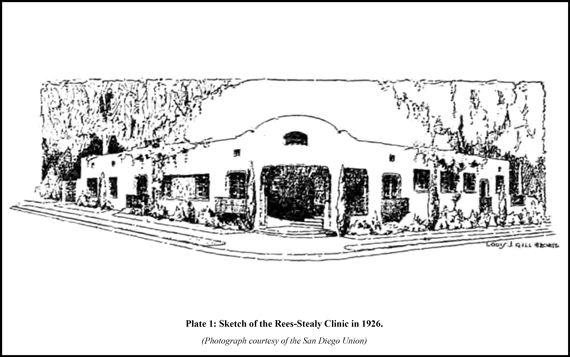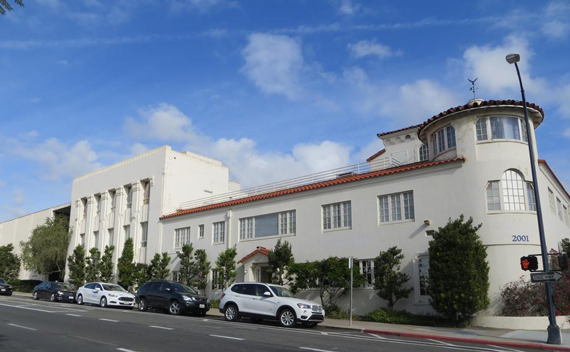|
Consequences of No Quorum at the Historical Resources Board (HRB)
Hurts Preservation Efforts, Including Rees-Stealy Medical Clinic
July/August 2017
By A. Hayes
 Original 1926 Mission Revival style clinic. |
 Dave Potter is center front, to his left is Lorie Zapf, to his right is Amie Hayes, SOHO's Historic Resources Specialist. Photos by Anthony Mournian |
The Rees-Stealy Medical Clinic, 2001 Fourth Avenue, was constructed in 1926 by Master Architect Louis Gill (the nephew of Irving Gill) as a single-story Mission Revival style clinic that wrapped around the corner of Fourth Avenue and Grape Street (see the architect's drawing). However, the clinic grew quickly. Upon completion of the building in 1928, Gill was immediately commissioned for a remodel and a second-story addition, which took on the Spanish Eclectic style. Employed again in 1938 to address the clinic's further growth, Gill designed a two-story Art Deco style addition north of the original building. Then in 1965, Master Architect Homer Delawie designed the northernmost addition in a fourth style: Mid-Century Modern.
This iconic Uptown building is significant for its two master architects and the multiple architectural styles they used in expanding the clinic. It is also important to the historic development of the Bankers Hill neighborhood as well as the clinic's institutional growth.
At their January 2017 meeting, the City of San Diego's Historical Resources Board reviewed the Rees-Stealy Medical Clinic. The Staff Report recommends designation under four criteria. This building is important to the development of Uptown (Criterion A); has a significant association to Drs. Clarence Rees and Clair Stealy (Criterion B); embodies characteristics of the Spanish Eclectic, Art Deco and Modern Contemporary styles (Criterion C); and represents notable work by two Master Architects, Louis Gill and Homer Delawie.
However, after lengthy public comment and board discussion, a motion passed (5-1) to return the report to the applicant and staff to clarify Homer Delawie's role in designing the 1965 addition and how the various periods of significance relate to the designation criteria (A, B, C and D).
The clinic was slated to come back before the HRB in March, but a quorum for this item could not be met. Again, in April, a lack of a quorum (for this item only) allowed the 90-day review period to expire. The HRB lost jurisdiction to designate because it had not taken action within 90 days.
This frustrating situation is a clear example why the HRB urgently needs a full complement of board members and members without regular conflicts of interest that require recusal.
The new owner, H. G. Fenton Company, has committed to SOHO in a letter to preserve the Louis Gill-designed Spanish Eclectic and Art Deco portions of the building in any new development, and they intend to restore the original corner entry if allowable by the City Building Department.
|
2025
2024
2023
2022
2021
2020
2019
2018
2017
2016
2015
|





